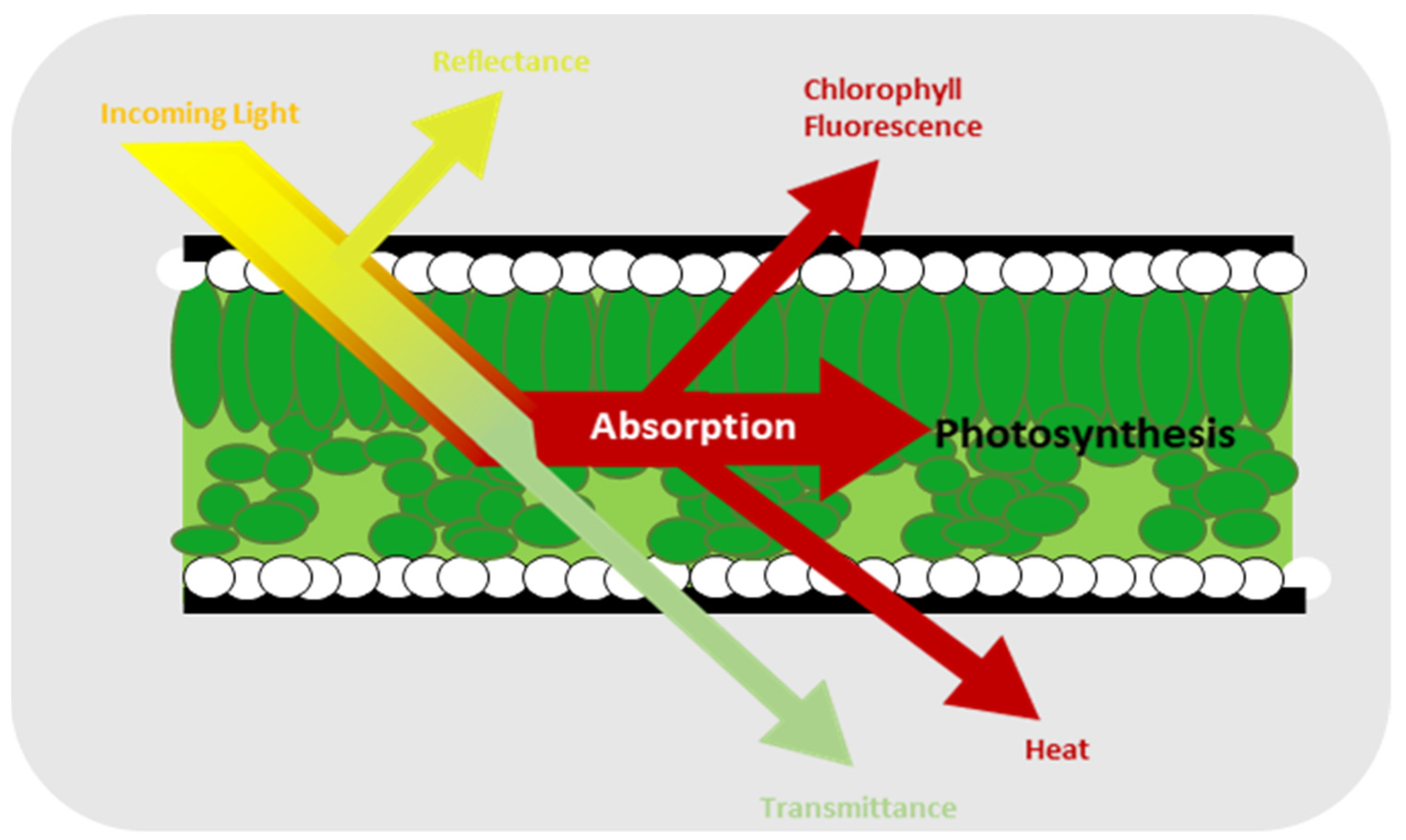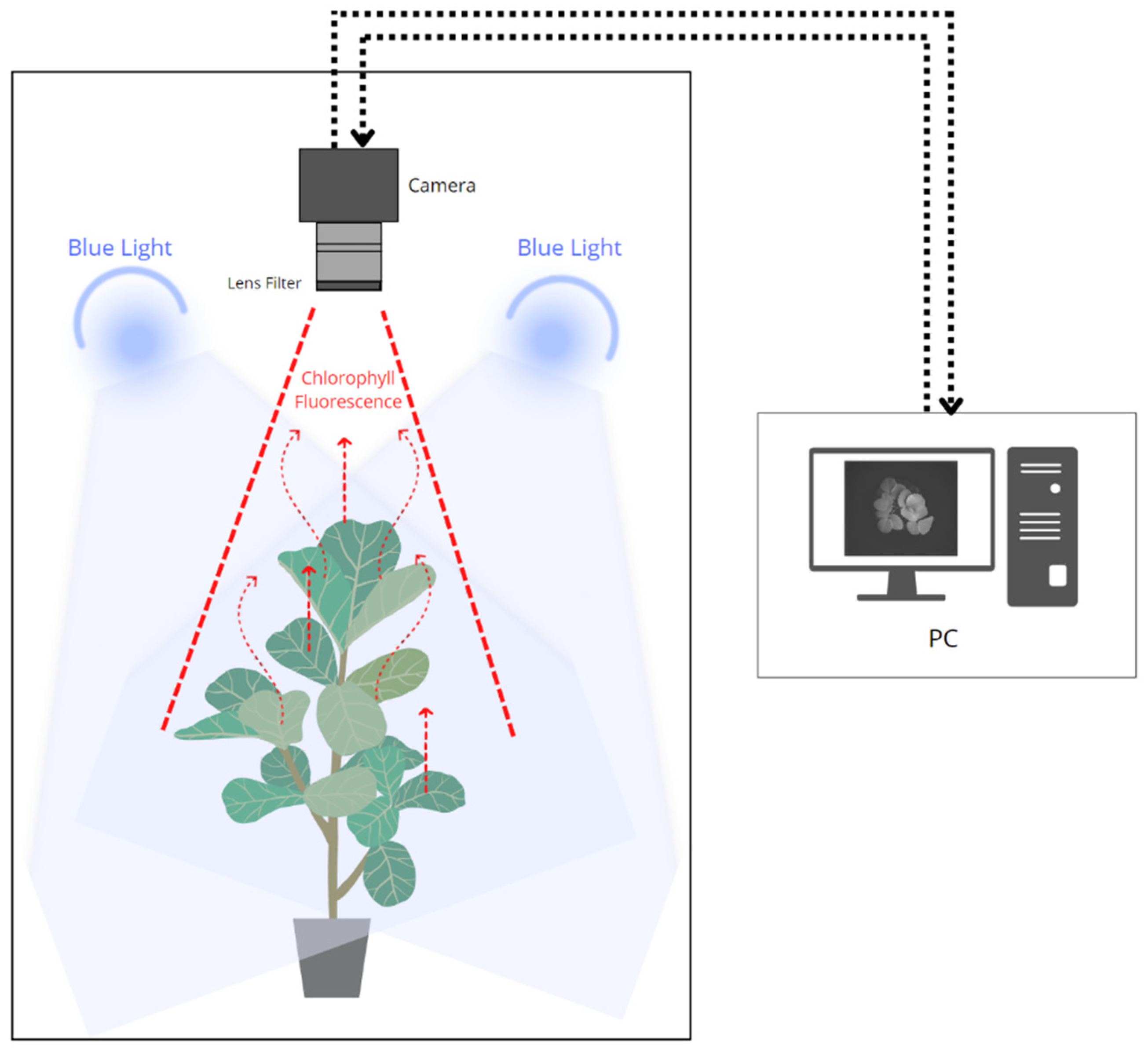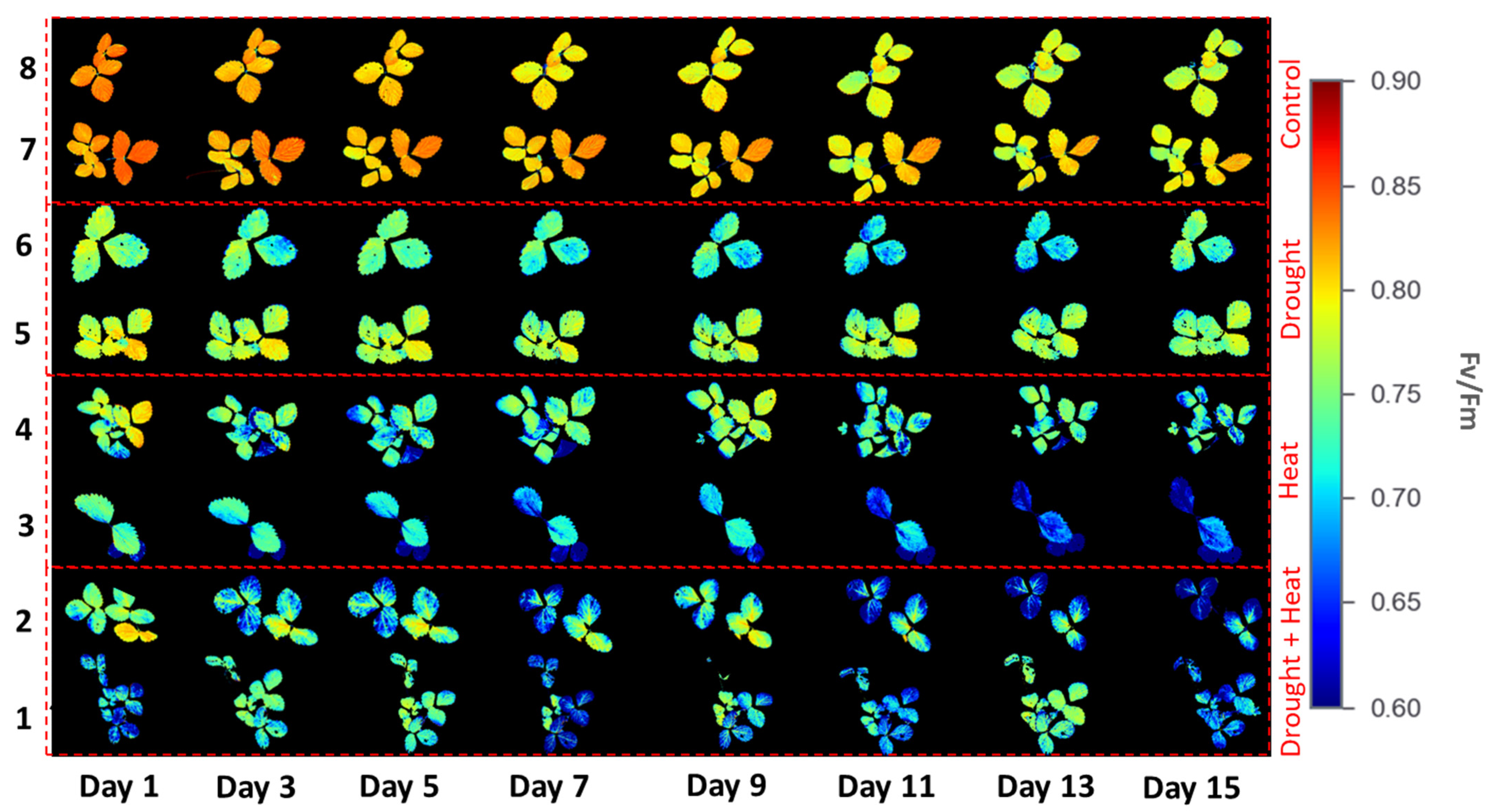Chlorophyll Fluorescence Imaging for Early Detection of Drought and Heat Stress in Strawberry Plants
Abstract
:1. Introduction
2. Materials and Methods
2.1. Plant Material and Growth Conditions
2.2. EMEX Matrix of Chlorophyll in Strawberry Leaves
2.3. Abiotic Stress Treatment
2.4. Relative Chlorophyll Content Measurement
2.5. Chlorophyll Fluorescence Measurement Using a Conventional Commercial System
2.6. Chlorophyll Fluorescence Measurement Using the Developed CFI System
2.7. Image Analysis
2.8. Statistical Analysis
3. Results
3.1. Emission-Excitation (EMEX) Matrix
3.2. System Evaluation
3.3. Chlorophyll Fluorescence Imaging
3.4. Fv/Fm Value from the Developed CFI System
3.5. Relative Chlorophyll Content
4. Discussion
5. Conclusions
Author Contributions
Funding
Institutional Review Board Statement
Informed Consent Statement
Data Availability Statement
Conflicts of Interest
References
- Fierascu, R.C.; Temocico, G.; Fierascu, I.; Ortan, A.; Babeanu, N.E. Fragaria Genus: Chemical Composition and Biological Activities. Molecules 2020, 25, 498. [Google Scholar] [CrossRef] [PubMed] [Green Version]
- Jeong, H.J.; Choi, H.G.; Moon, B.Y.; Cheong, J.W.; Kang, N.J. Comparative Analysis of the Fruit Characteristics of Four Strawberry Cultivars Commonly Grown in South Korea. Hortic. Sci. Technol. 2016, 34, 396–404. [Google Scholar] [CrossRef]
- Roussos, P.A.; Ntanos, E.; Tsafouros, A.; Denaxa, N.K. Strawberry Physiological and Biochemical Responses to Chilling and Freezing Stress and Application of Alleviating Factors as Countermeasures. J. Berry Res. 2020, 10, 437–457. [Google Scholar] [CrossRef]
- Simpson, J.V.; Burke, M.; Jiji, R.D. Application of EEM Fluorescence in Combination with PARAFAC Analysis to Simultaneously Monitor Quercetin in Its Deprotonated, Aggregated, and Protein Bound States. J. Chemom. 2011, 25, 101–108. [Google Scholar] [CrossRef]
- Park, S.; Kim, J. Design and Implementation of a Hydroponic Strawberry Monitoring and Harvesting Timing Information Supporting System Based on Nano Ai-Cloud and Iot-Edge. Electronics 2021, 10, 1400. [Google Scholar] [CrossRef]
- Cho, G.; Kwak, Y.S. Genetic Variation of Strawberry Fusarium Wilt Pathogen Population in Korea. Mycobiology 2022, 50, 82–88. [Google Scholar] [CrossRef]
- Rubinstein, J. Fragaria x ananassa: Past, Present and Future Production of the Modern Strawberry; University of Minnesota: Minneapolis, MN, USA, 2015; pp. 1–30. [Google Scholar]
- Kang, D.I.; Hu, J.; Li, Y.; Jeong, B.R. Growth, Productivity, and Quality of Strawberry as Affected by Propagation Method and Cultivation System. Prot. Hortic. Plant Fact. 2020, 29, 326–336. [Google Scholar] [CrossRef]
- Liang, J.; Zheng, J.; Wu, Z.; Wang, H. Strawberry FaNAC2 Enhances Tolerance to Abiotic Stress by Regulating Proline Metabolism. Plants 2020, 9, 1417. [Google Scholar] [CrossRef]
- Kadir, S.; Sidhu, G.; Al-Khatib, K. Strawberry (Fragaria × ananassa Duch.) Growth and Productivity as Affected by Temperature. HortScience 2006, 41, 1423–1430. [Google Scholar] [CrossRef] [Green Version]
- Cordoba-Novoa, H.A.; Cruz, B.E.; Flórez, N.; Magnitskiy, S.; Moreno, L.P. Shading Reduces Water Deficit in Strawberry (Fragaria × ananassa Duch.) Plants during Vegetative Growth; McGill University: Montreal, QC, Canada, 2021; manuscript in preparation. [Google Scholar]
- Sun, C.H.; Li, X.H.; Hu, Y.L.; Zhao, P.; Xu, T.; Sun, J.; Gao, X.L. Proline, Sugars, and Antioxidant Enzymes Respond to Drought Stress in the Leaves of Strawberry Plants. Korean J. Hortic. Sci. Technol. 2015, 33, 625–632. [Google Scholar] [CrossRef] [Green Version]
- Bhusal, N.; Han, S.G.; Yoon, T.M. Impact of Drought Stress on Photosynthetic Response, Leaf Water Potential, and Stem Sap Flow in Two Cultivars of Bi-Leader Apple Trees (Malus × domestica Borkh.). Sci. Hortic. 2019, 246, 535–543. [Google Scholar] [CrossRef]
- Ledesma, N.A.; Nakata, M.; Sugiyama, N. Effect of High Temperature Stress on the Reproductive Growth of Strawberry Cvs. “Nyoho” and “Toyonoka”. Sci. Hortic. 2008, 116, 186–193. [Google Scholar] [CrossRef]
- Arief, M.A.A.; Nugroho, A.P.; Putro, A.W.; Dananta, D.H.; Masithoh, R.E.; Sutiarso, L.; Okayasu, T. Three-Dimensional (3D) Reconstruction for Non-Destructive Plant Growth Observation System Using Close-Range Photogrammetry. IOP Conf. Ser. Earth Environ. Sci. 2021, 733, 012028. [Google Scholar] [CrossRef]
- Yang, P. Interpretation of Sun-Induced Chlorophyll Fluorescence for Remote Sensing of Photosynthesis; University of Twente, Faculty of Geo-Information Science and Earth Observation (ITC): Enschede, The Netherlands, 2018. [Google Scholar]
- Maxwell, K.; Johnson, G.N. Chlorophyll Fluorescence—A Practical Guide. J. Exp. Bot. 2000, 51, 659–668. [Google Scholar] [CrossRef]
- Guidi, L.; Lo Piccolo, E.; Landi, M. Chlorophyll Fluorescence, Photoinhibition and Abiotic Stress: Does It Make Any Difference the Fact to Be a C3 or C4 Species? Front. Plant Sci. 2019, 10, 174. [Google Scholar] [CrossRef]
- Torres, R.; Romero, J.M.; Lagorio, M.G. Effects of Sub-Optimal Illumination in Plants. Comprehensive Chlorophyll Fluorescence Analysis. J. Photochem. Photobiol. B Biol. 2021, 218, 112182. [Google Scholar] [CrossRef]
- Lyndby, N.H.; Kuhl, M.; Wangpraseurt, D. Heat Generation and Light Scattering of Green Fluorescent Protein-like Pigments in Coral Tissue. Sci. Rep. 2016, 6, 26599. [Google Scholar] [CrossRef] [Green Version]
- Tung, J.; Goodwin, P.H.; Hsiang, T. Chlorophyll Fluorescence for Quantification of Fungal Foliar Infection and Assessment of the Effectiveness of an Induced Systemic Resistance Activator. Eur. J. Plant Pathol. 2013, 136, 301–315. [Google Scholar] [CrossRef]
- Rios, J.A.; Aucique-Pérez, C.E.; Debona, D.; Cruz Neto, L.B.M.; Rios, V.S.; Rodrigues, F.A. Changes in Leaf Gas Exchange, Chlorophyll a Fluorescence and Antioxidant Metabolism within Wheat Leaves Infected by Bipolaris Sorokiniana. Ann. Appl. Biol. 2017, 170, 189–203. [Google Scholar] [CrossRef]
- Mahlein, A.K.; Oerke, E.C.; Steiner, U.; Dehne, H.W. Recent Advances in Sensing Plant Diseases for Precision Crop Protection. Eur. J. Plant Pathol. 2012, 133, 197–209. [Google Scholar] [CrossRef]
- Banks, J.M. Continuous Excitation Chlorophyll Fluorescence Parameters: A Review for Practitioners. Tree Physiol. 2017, 37, 1128–1136. [Google Scholar] [CrossRef] [PubMed]
- Hou, H.J.M.; Najafpour, M.M.; Moore, G.F.; Allakhverdiev, S.I. Photosynthesis: Structures, Mechanisms, and Applications; Springer: Cham, Switzerland, 2017; pp. 1–417. [Google Scholar] [CrossRef]
- Suárez, J.C.; Vanegas, J.I.; Contreras, A.T.; Anzola, J.A.; Urban, M.O.; Beebe, S.E.; Rao, I.M. Chlorophyll Fluorescence Imaging as a Tool for Evaluating Disease Resistance of Common Bean Lines in the Western Amazon Region of Colombia. Plants 2022, 11, 1371. [Google Scholar] [CrossRef] [PubMed]
- Lichtenthaler, H.K.; Buschmann, C.; Knapp, M. How to Correctly Determine the Different Chlorophyll Fluorescence Parameters and the Chlorophyll Fluorescence Decrease Ratio RFd of Leaves with the PAM Fluorometer. Photosynthetica 2005, 43, 379–393. [Google Scholar] [CrossRef]
- Schreiber, U.; Klughammer, C. Non-Photochemical Fluorescence Quenching and Quantum Yields in PS I and PS II: Analysis of Heat-Induced Limitations Using Maxi-Imaging- PAM and Dual-PAM-100. PAM Appl. Notes 2008, 1, 15–18. [Google Scholar]
- Kalaji, H.M.; Schansker, G.; Ladle, R.J.; Goltsev, V.; Bosa, K.; Allakhverdiev, S.I.; Brestic, M.; Bussotti, F.; Calatayud, A.; Dąbrowski, P.; et al. Frequently Asked Questions about in Vivo Chlorophyll Fluorescence: Practical Issues. Photosynth. Res. 2014, 122, 121–158. [Google Scholar] [CrossRef] [Green Version]
- Baker, N.R.; Rosenqvist, E. Applications of Chlorophyll Fluorescence Can Improve Crop Production Strategies: An Examination of Future Possibilities. J. Exp. Bot. 2004, 55, 1607–1621. [Google Scholar] [CrossRef] [Green Version]
- Baker, N.R. Chlorophyll Fluorescence: A Probe of Photosynthesis in Vivo. Annu. Rev. Plant Biol. 2008, 59, 89–113. [Google Scholar] [CrossRef] [Green Version]
- Bussotti, F.; Gerosa, G.; Digrado, A.; Pollastrini, M. Selection of Chlorophyll Fluorescence Parameters as Indicators of Photosynthetic Efficiency in Large Scale Plant Ecological Studies. Ecol. Indic. 2020, 108, 105686. [Google Scholar] [CrossRef]
- Na, Y.W.; Jeong, H.J.; Lee, S.Y.; Choi, H.G.; Kim, S.H.; Rho, I.R. Chlorophyll Fluorescence as a Diagnostic Tool for Abiotic Stress Tolerance in Wild and Cultivated Strawberry Species. Hortic. Environ. Biotechnol. 2014, 55, 280–286. [Google Scholar] [CrossRef]
- Choi, H.G.; Moon, B.Y.; Kang, N.J. Correlation between Strawberry (Fragaria ananassa Duch.) Productivity and Photosynthesis-Related Parameters under Various Growth Conditions. Front. Plant Sci. 2016, 7, 1607. [Google Scholar] [CrossRef] [Green Version]
- Vlaovic, J.; Balen, J.; Grgic, K.; Zagar, D.; Galic, V.; Simic, D. An Overview of Chlorophyll Fluorescence Measurement Process, Meters and Methods. In Proceedings of the 2020 International Conference on Smart Systems and Technologies (SST), Osijek, Croatia, 14–16 October 2020; pp. 245–250. [Google Scholar] [CrossRef]
- Moustakas, M.; Calatayud, A.; Guidi, L. Chlorophyll Fluorescence Imaging Analysis in Biotic and Abiotic Stress. Front. Plant Sci. 2021, 12, 658500. [Google Scholar] [CrossRef] [PubMed]
- Herritt, M.T.; Pauli, D.; Mockler, T.C.; Thompson, A.L. Chlorophyll Fluorescence Imaging Captures Photochemical Efficiency of Grain Sorghum (Sorghum bicolor) in a Field Setting. Plant Methods 2020, 16, 109. [Google Scholar] [CrossRef] [PubMed]
- Legendre, R.; Basinger, N.T.; van Iersel, M.W. Low-Cost Chlorophyll Fluorescence Imaging for Stress Detection. Sensors 2021, 21, 2055. [Google Scholar] [CrossRef] [PubMed]
- Nedbal, L.; Whitmarsh, J. Chapter 14: Chlorophyll Fluorescence Imaging of Leaves and Fruits. In Chlorophyll Fluorescence: A Signature of Photosynthesis; Papageorgiou, G.C., Govindjee, Eds.; Kluwer Academic: Alphen aan den Rijn, The Netherlands, 2004; pp. 1–19. ISBN 9781452289830. [Google Scholar]
- Imakumbili, M.L.E.; Semu, E.; Semoka, J.M.R.; Abass, A.; Mkamilo, G. Managing Cassava Growth on Nutrient Poor Soils under Different Water Stress Conditions. Heliyon 2021, 7, e07331. [Google Scholar] [CrossRef] [PubMed]
- ÖDEMİŞ, B.; CANDEMİR, D.K.; EVRENDİLEK, F. Responses to Drought Stress Levels of Strawberry Grown in Greenhouse Conditions. Hortic. Stud. 2020, 37, 113–122. [Google Scholar] [CrossRef]
- Yuan, Z.; Cao, Q.; Zhang, K.; Ata-Ul-Karim, S.T.; Tan, Y.; Zhu, Y.; Cao, W.; Liu, X. Optimal Leaf Positions for SPAD Meter Measurement in Rice. Front. Plant Sci. 2016, 7, 719. [Google Scholar] [CrossRef] [Green Version]
- Padhi, B.; Chauhan, G.; Kandoi, D.; Stirbet, A.; Tripathy, B.C.; Govindjee, G. A Comparison of Chlorophyll Fluorescence Transient Measurements, Using Handy Pea and Fluorpen Fluorometers. Photosynthetica 2021, 59, 399–408. [Google Scholar] [CrossRef]
- Kim, D.-S.; Kim, J.-W. Diagnosis Method of Abiotic Stress or Herbicide Response of Plants Using Chlorophyll Fluorescence Imaging. Korea Patent 1020160052367, 12 May 2016. [Google Scholar]
- Noble, E.; Kumar, S.; Görlitz, F.G.; Stain, C.; Dunsby, C.; French, P.M.W. In Vivo Label-Free Mapping of the Effect of a Photosystem II Inhibiting Herbicide in Plants Using Chlorophyll Fluorescence Lifetime. Plant Methods 2017, 13, 48. [Google Scholar] [CrossRef] [Green Version]
- Donaldson, L. Autofluorescence in Plants. Molecules 2020, 25, 2393. [Google Scholar] [CrossRef]
- Shahenshah; Isoda, A. Effects of Water Stress on Leaf Temperature and Chlorophyll Fluorescence Parameters in Cotton and Peanut. Plant Prod. Sci. 2010, 13, 269–278. [Google Scholar] [CrossRef]
- Jia, M.; Li, D.; Colombo, R.; Wang, Y.; Wang, X.; Cheng, T.; Zhu, Y.; Yao, X.; Xu, C.; Ouer, G.; et al. Quantifying Chlorophyll Fluorescence Parameters from Hyperspectral Reflectance at the Leaf Scale under Various Nitrogen Treatment Regimes in Winter Wheat. Remote Sens. 2019, 11, 2838. [Google Scholar] [CrossRef] [Green Version]
- Fan, S.T.; Yeh, D.M.; Chen, S.J. Genotypic Differences in Post-Storage Photosynthesis and Leaf Chloroplasts in Response to Ethylene and 1-Methylcyclopropene in Aglaonema. Postharvest Biol. Technol. 2013, 76, 98–105. [Google Scholar] [CrossRef]
- Bhusal, N.; Lee, M.; Reum Han, A.; Han, A.; Kim, H.S. Responses to Drought Stress in Prunus Sargentii and Larix Kaempferi Seedlings Using Morphological and Physiological Parameters. For. Ecol. Manag. 2020, 465, 118099. [Google Scholar] [CrossRef]
- Bhusal, N.; Lee, M.; Lee, H.; Adhikari, A.; Han, A.R.; Han, A.; Kim, H.S. Evaluation of Morphological, Physiological, and Biochemical Traits for Assessing Drought Resistance in Eleven Tree Species. Sci. Total Environ. 2021, 779, 146466. [Google Scholar] [CrossRef]
- Salmon, Y.; Dietrich, L.; Sevanto, S.; Hölttä, T.; Dannoura, M.; Epron, D. Drought Impacts on Tree Phloem: From Cell-Level Responses to Ecological Significance. Tree Physiol. 2018, 39, 173–191. [Google Scholar] [CrossRef] [PubMed] [Green Version]
- Raja, V.; Qadir, S.U.; Alyemeni, M.N.; Ahmad, P. Impact of Drought and Heat Stress Individually and in Combination on Physio-Biochemical Parameters, Antioxidant Responses, and Gene Expression in Solanum Lycopersicum. 3 Biotech 2020, 10, 208. [Google Scholar] [CrossRef]
- Wang, G.; Peng, M.; Wang, Y.; Chen, Z.; Zhu, S. Preharvest Hydrogen Peroxide Treatment Delays Leaf Senescence of Chinese Flowering Cabbage During Storage by Reducing Water Loss and Activating Antioxidant Defense System. Front. Plant Sci. 2022, 13, 856646. [Google Scholar] [CrossRef]
- Jägerbrand, A.K.; Kudo, G. Short-Term Responses in Maximum Quantum Yield of PSII (Fv/Fm) to Ex Situ Temperature Treatment of Populations of Bryophytes Originating from Different Sites in Hokkaido, Northern Japan. Plants 2016, 5, 22. [Google Scholar] [CrossRef] [Green Version]
- Osório, J.; Osório, M.L.; Correia, P.J.; de Varennes, A.; Pestana, M. Chlorophyll Fluorescence Imaging as a Tool to Understand the Impact of Iron Deficiency and Resupply on Photosynthetic Performance of Strawberry Plants. Sci. Hortic. 2014, 165, 148–155. [Google Scholar] [CrossRef]
- Wang, H.; Qian, X.; Zhang, L.; Xu, S.; Li, H.; Xia, X.; Dai, L.; Xu, L.; Yu, J.; Liu, X. A Method of High Throughput Monitoring Crop Physiology Using Chlorophyll Fluorescence and Multispectral Imaging. Front. Plant Sci. 2018, 9, 407. [Google Scholar] [CrossRef] [Green Version]
- Konishi, A.; Eguchi, A.; Hosoi, F.; Omasa, K. 3D Monitoring Spatio-Temporal Effects of Herbicide on a Whole Plant Using Combined Range and Chlorophyll a Fluorescence Imaging. Funct. Plant Biol. 2009, 36, 874–879. [Google Scholar] [CrossRef] [PubMed]
- Senesi, G.S.; De Pascale, O.; Marangoni, B.S.; Caires, A.R.L.; Nicolodelli, G.; Pantaleo, V.; Leonetti, P. Chlorophyll Fluorescence Imaging (CFI) and Laser-Induced Breakdown Spectroscopy (LIBS) Applied to Investigate Tomato Plants Infected by the Root Knot Nematode (RKN) Meloidogyne Incognita and Tobacco Plants Infected by Cymbidium Ringspot Virus. Photonics 2022, 9, 627. [Google Scholar] [CrossRef]










Disclaimer/Publisher’s Note: The statements, opinions and data contained in all publications are solely those of the individual author(s) and contributor(s) and not of MDPI and/or the editor(s). MDPI and/or the editor(s) disclaim responsibility for any injury to people or property resulting from any ideas, methods, instructions or products referred to in the content. |
© 2023 by the authors. Licensee MDPI, Basel, Switzerland. This article is an open access article distributed under the terms and conditions of the Creative Commons Attribution (CC BY) license (https://creativecommons.org/licenses/by/4.0/).
Share and Cite
Arief, M.A.A.; Kim, H.; Kurniawan, H.; Nugroho, A.P.; Kim, T.; Cho, B.-K. Chlorophyll Fluorescence Imaging for Early Detection of Drought and Heat Stress in Strawberry Plants. Plants 2023, 12, 1387. https://doi.org/10.3390/plants12061387
Arief MAA, Kim H, Kurniawan H, Nugroho AP, Kim T, Cho B-K. Chlorophyll Fluorescence Imaging for Early Detection of Drought and Heat Stress in Strawberry Plants. Plants. 2023; 12(6):1387. https://doi.org/10.3390/plants12061387
Chicago/Turabian StyleArief, Muhammad Akbar Andi, Hangi Kim, Hary Kurniawan, Andri Prima Nugroho, Taehyun Kim, and Byoung-Kwan Cho. 2023. "Chlorophyll Fluorescence Imaging for Early Detection of Drought and Heat Stress in Strawberry Plants" Plants 12, no. 6: 1387. https://doi.org/10.3390/plants12061387
APA StyleArief, M. A. A., Kim, H., Kurniawan, H., Nugroho, A. P., Kim, T., & Cho, B.-K. (2023). Chlorophyll Fluorescence Imaging for Early Detection of Drought and Heat Stress in Strawberry Plants. Plants, 12(6), 1387. https://doi.org/10.3390/plants12061387







